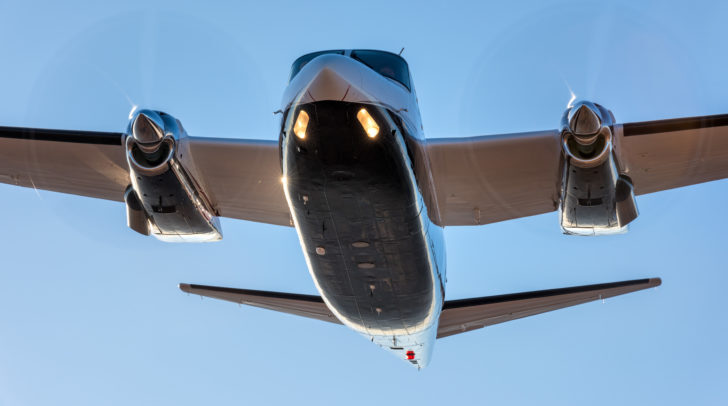By Dale Barnard and Tom Surgalski — Gallagher Aviation Practice

“Aerodynamics are for people who can’t build engines.”
—Enzo Ferrari
Brace yourself: We have officially entered the age where an off-the-shelf turboprop aircraft can fly at jet speeds but at turboprop altitudes on less fuel. Enzo Ferrari’s famous quote epitomizes the age-old thrust-over-drag argument. Today’s turboprops, however, use every trick in the book to eke out more speed by increasing thrust and reducing drag, while increasing payload, maximum range, and comfort – all with top-notch flight- management systems. Add composite airframes and you have the recipe for a fast bird.
We are reviewing twin- and single-engine turboprop segment activity since 2nd Quarter 2016. While much has changed, including the addition of the Quest Kodiak 100 to our roster, many stalwarts remain. Here’s the 411 on this segment.
Twin Engine Turboprops
Avanti Piaggio announced that the new and improved Avanti 180, the EVO, will begin deliveries in 4th Quarter 2017. The EVO claims a 402-knot max speed, 41,000-foot service ceiling, a 1,770-nm range, 40% greater fuel economy than a turbojet, and one of the segments’ most spacious, quiet cabins. Piaggio has also jumped into UAVs in a big way, partnering with Leonardo to develop the P.1HH turboprop UAV geared for the military.
Beechcraft/KingAir: Walter Beech would have been proud had he lived long enough to see the King Air — 53 years of continuous production have made this twin turboprop a legend, a legacy, and the backbone of modern general aviation. In an effort to keep the product line fresh, the factory offers custom completion upgrades beyond the factory’s standard technological advancements.
For 2017, production for the entire line is about half of last year’s production. It appears the lion’s share of deliveries were in the 350 line to Wheels Up, the aircraft membership club. Service, support, and parts remain strong and well-positioned to meet the needs of more than 6,000 aircraft worldwide.
The Piper Cheyennes are still popular in certain segments: 734 remain active, split evenly between U.S. and international registry.
The Cessna Conquest’s fleet favors U.S. operators by a 2 to 1 margin; 505 airframes remain active overall.
Swearingen Merlin Metro fleets have dropped slightly, with 226 airframes split evenly between U.S. and international registry.
Mitsubishi MU-2: Unfortunately, the updated data is unverified. Regardless, fewer than half of the 714 produced remain active.
Twin Commander: Of the 697 active airframes, 37 transferred from U.S. to international registry, making the international registry dominate over the domestic registry by a 2-to-1 margin.
Single Engine Turboprops
The Cessna Caravan’s production increased by 76 airframes while international registry tops domestic by a factor of nearly 4 to 1. Caravan and Caravan Grand EX remain popular as Cessna’s sport-utility turboprop. Cessna inches forward with the development of what appears to be a single-engine, cabin-class PC-12 doppelganger.
Piper Meridian M500-600 production increased by 53 airframes as the new 600 gains traction. International deliveries outpaced domestics by 4 to 1. The Meridian line remains a popular way to transition into a turboprop.
Pilatus PC-12 production increased by 71 airframes, increasing the fleet to 1,503 airframes. Domestic registries outnumber international by more than a 2 to 1 factor. This business and pleasure workhorse owes its continued popularity to its great reputation with pilots and operators alike.
Daher TBM production increased by 73 airframes while registries favor the U.S. by a factor of nearly 3 to 1. Never to be accused of letting dust settle, Daher now offers the TBM 910 with Garmin’s G1000NXI avionics suite and the TBM 930 with Garmin G3000 touchscreen digital avionics.
The Quest Kodiak 100, first produced in 2007, is our latest addition to the turboprop fleet report. Purpose-built for operating in austere environments, this aircraft is a true off-road SUV. While its appearance has been mistaken by some as a Caravan, its performance numbers leave little doubt that this 10-seat turboprop excels where others fear to tread. To date, 226 airframes have been produced with registries split evenly between domestic and international.

Summary
Overall, this entire segment, excluding the Kodiak 100, has grown 9% in the last three years and 2.2% in the last 12 months. Since 2014 we have seen a gradual shift of turboprop fleet registries. In 2014, U.S. registries in this segment were 13% greater than international registries. This trend has now reversed with international registries posting a 4.8% advantage over U.S. registries. This means that since 2014 the U.S. registry has grown by only 3.4% whereas the international registry has grown 22.5%.
As the performance and utility of this turboprop segment increases, so does the mission profile. We are seeing turboprops displace business jets and others used as cargo haulers in environments previously served only by ground vehicles. Enzo Ferrari solved one performance aspect by adding horsepower to his race cars. Today’s turboprop OEMs have literally changed the flight envelope.
Dale Barnard is the air medical team leader of the Gallagher Aviation Practice and also manages the Twin Commander Insurance Program. He is a member of the Association of Air Medical Services and the Airborne Law Enforcement Association. Contact him at dale_barnard@ajg.com.
